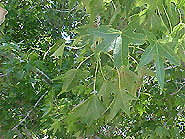Friday, June 18, 2004
Maple or sweetgum?
I called our favorite tree experts the other day to make arrangements for them to trim some trees in our side garden. In talking with Terry, I told her we wanted two cabbage palms trimmed as well as the maple tree. She looked through our records and then told me that they must have missed the maple last time they were here because there was nothing noted in our file. Terry then read through the list, garden by garden, and, as she mentioned two sweetgum trees it became apparent that I had misidentified our trees.
 So, being the curious person that I am, I turned to my garden library for more info. Sure enough, there in my favorite Florida reference I found sweetgum trees. Sweetgum looks similar to a maple in their leaf shape. This deciduous tree produces a 5-lobed leaf that turns red in the fall. It reaches anywhere from 40 to 125 feet in height, and 20-60 feet in its spread. Also known as Liquidambar styraciflua, the tree tolerates a variety of soil and water conditions and is native to the southeast.
So, being the curious person that I am, I turned to my garden library for more info. Sure enough, there in my favorite Florida reference I found sweetgum trees. Sweetgum looks similar to a maple in their leaf shape. This deciduous tree produces a 5-lobed leaf that turns red in the fall. It reaches anywhere from 40 to 125 feet in height, and 20-60 feet in its spread. Also known as Liquidambar styraciflua, the tree tolerates a variety of soil and water conditions and is native to the southeast.
Maples also produce 5-lobed leaves that turn red and drop in winter months. They don't get as tall at 20-25 feet or wide at 20-40 feet. This tree also tolerates a variety of conditions and there is a Florida maple also known as a sugar maple or acer barbatum . That's what I thought was growing in our garden and providing wonderful shade on that side of the house. The biggest distinguishing factor between the two besides size is the "gum ball" produced by the sweetgum. When I was a kid we called them monkey balls, a spiky fruit that holds seeds.
Well, the old saying goes that you learn something new every day and I know I sure do. I guess that's why Terry's company, Westenberger Tree Service is the expert and I'm not. At least now I won't mix my sweetgums with my maples. Happy Florida Gardening.
 So, being the curious person that I am, I turned to my garden library for more info. Sure enough, there in my favorite Florida reference I found sweetgum trees. Sweetgum looks similar to a maple in their leaf shape. This deciduous tree produces a 5-lobed leaf that turns red in the fall. It reaches anywhere from 40 to 125 feet in height, and 20-60 feet in its spread. Also known as Liquidambar styraciflua, the tree tolerates a variety of soil and water conditions and is native to the southeast.
So, being the curious person that I am, I turned to my garden library for more info. Sure enough, there in my favorite Florida reference I found sweetgum trees. Sweetgum looks similar to a maple in their leaf shape. This deciduous tree produces a 5-lobed leaf that turns red in the fall. It reaches anywhere from 40 to 125 feet in height, and 20-60 feet in its spread. Also known as Liquidambar styraciflua, the tree tolerates a variety of soil and water conditions and is native to the southeast.
Maples also produce 5-lobed leaves that turn red and drop in winter months. They don't get as tall at 20-25 feet or wide at 20-40 feet. This tree also tolerates a variety of conditions and there is a Florida maple also known as a sugar maple or acer barbatum . That's what I thought was growing in our garden and providing wonderful shade on that side of the house. The biggest distinguishing factor between the two besides size is the "gum ball" produced by the sweetgum. When I was a kid we called them monkey balls, a spiky fruit that holds seeds.
Well, the old saying goes that you learn something new every day and I know I sure do. I guess that's why Terry's company, Westenberger Tree Service is the expert and I'm not. At least now I won't mix my sweetgums with my maples. Happy Florida Gardening.
Comments:
Post a Comment

This work is licensed under a Creative Commons License.
Thanks to Andrew Stenning who contributed the photograph for our masthead


